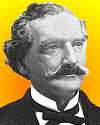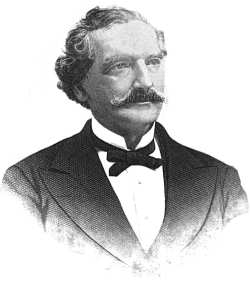 (source)
(source)
|
Gardner Quincy Colton
(7 Feb 1814 - 9 Aug 1898)
American lecturer who was the first to administer nitrous oxide as an anaesthetic. He gave scientific lectures, and his exhibited nitrous oxide gas. Later, he started The Colton Dental Association of New York, where dentists successfully used it as an anaesthetic.
|
Gardner Quincy Colton and Nitrous Oxide Anaesthesia
From History of New York City (1884)
[Intially, nitrous oxide (laughing gas) was exhibited by Gardner Quincy Colton as a novelty demonstrating its mirth-provoking effects. It's value as a dental anaesthetic was recognized by Dr. Horace Wells, who adopted its use in his dental practice, though its use did not spread at that time. Eventually, it was Colton, though not a dentist himself, who popularized its use in dentistry to replace the more risky method of using chloroform and ether. Acceptance in the profession was slow, but eventual Colton gained fame from his efforts. The article below focusses on this aspect of his life. Yet Colton was known also for more diverse interests. He exhibited a model railway in 1847, using a metallic track in the circuit to supply electricity to the locomotive's motor. He was also a Shakesperean scholar.]
[p.780] The Colton Dental Association of New York, founded during this decade, has a remarkable history. It was established by Dr. Gardner Quincy Colton, who in his early manhood had prepared for the practice of medicine, and was widely known as a lecturer on chemistry and natural philosophy. He made pleasing exhibitions of the effect of nitrous oxide or “laughing gas.” While lecturing at Hartford, in December, 1844. Dr. Colton administered the gas to several persons. Among those present was Dr. Horace Wells, a dentist of that city. One of those who inhaled the gas, under the violent excitement caused by its inhalation, struck himself against the benches with such force that the blood flowed from his bruised shins, and yet he declared he felt no pain until the operation of the gas had ceased. Impressed with [p.781] this fact, Dr. Wells the next day induced Colton to administer the gas to him, and while under its effects he had a neighboring dentist extract a molar tooth. It was done without pain. Here was a wonderful discovery—perhaps the most beneficent in its effects of any discovery of the century. Dr. Colton was the occasion of the discovery. This was two years before experiments in ether had been made, and three years before chloroform was discovered.
Dr. Wells adopted this wonderful anaesthetic in his practice with great success. He was ridiculed, and even persecuted, He died a martyr in 1848, before he could convince the medical and dental profession of the value of the gas as an anaesthetic, and it was forgotten.* More than twenty years afterward Dr. Colton revived it, established the value of the discovery, and in 1863 founded in the city of New York the Colton Dental Association. Not being a dentist himself, Dr. Colton employed expert practitioners. He simply administered the gas while they operated. The method soon became very popular, and now almost every leading dentist in the city sends him patients who need an anaesthetic, and there is scarcely a physician in the city who does not do the same. From February, 1864, until now (November, 1883) Dr. Colton has administered the gas to about one hundred and thirty-five thousand persons, whose names and autographs he has on record.
Gardner Quincy Colton is the youngest of a family of twelve children of Deacon Walter and Thankful (Cobb) Colton. He was born in Georgia, Vermont, February 7, 1814. He learned the business of a chairmaker at St. Albans, worked at his trade in New York from 1835 to 1842, and then he studied medicine in the office of Dr. Willard Parker and attended the required course of lectures at the College of Physicians and Surgeons. At the close of his studies he began lecturing on chemistry and natural philosophy, and at Hartford, on December 10, 1844, occurred the event mentioned in the text, which led to a great discovery. Dr. Colton instructed Dr. Wells how to make the gas, and then continued his lecturing tour.
In 1849 Dr. Colton went to California, where his brother, the Rev. Walter Colton, had filled the office of civil governor of the Territory. On his return to New York he became a correspondent from that city of the Boston Transcript. After engaging in several enterprises he resumed his scientific lectures, and his exhibitions of nitrous oxide gas, in 1861. Having observed that the danger attending the use of ether and chloroform was making them unpopular as anaesthetics, he determined to revive the use of nitrous oxide gas as such, and, if possible, demonstrate its value to the dental profession. At New Haven Dr. Colton induced a dentist to extract teeth for one week while he should administer the gas in subduing pain. The experiment was entirely successful. They continued the business three weeks, during which time they extracted over three thousand teeth without pain. So triumphant was the result that Dr. Colton determined to go to New York and establish the business of extracting teeth, under the influence of gas. There [p.782] he associated himself with three distinguished dentists under the name of the Colton Dental Association. Then began a great battle. The dental profession declared that it was only a revival of an old imposture—a method long ago tried and abandoned as a failure. Every species of abuse and ridicule was employed against the association, and it was nearly a year before the receipts exceeded the expenditures. Dr. Colton's associates, discouraged, withdrew ; but he, strong in his faith, persevered, “fought the good fight,” and conquered. He spent every cent he could spare in advertising; his business steadily increased, and every customer, satisfied, became an advertisement. He increased his working force, overcame all prejudice and opposition, and established a business which has won for him fame and fortune.
In 1867 Dr. Colton attended the International Exposition at Paris, where he exhibited his apparatus and demonstrated the value of the gas as an anaesthetic to the scientific world. He accepted an invitation of the late T. W. Evans, the Emperor's dentist, to remain with him a year and give him thorough instruction in the manufacture and use of the gas. Then he travelled in Europe with his family six months, went to London, and assisted Charles James Fox, an eminent dentist of that city (who had begun using the gas), in developing and establishing its value there.
The children of the elder Colton started in business life without an inherited dollar, but richly freighted with the results of sound moral and religious training and inherited virtuous qualities as well as wise instruction from their parents. They all prospered. The Rev. Walter Colton was a chaplain in the United States Navy, and was well known in the literary world. The doctor himself is a chaste writer. In theology he is a Unitarian. He is an earnest Christian worker and a most exemplary citizen in all the relations of life.
* In Bushnell Park, in the city of Hartford, is a fine bronze statue of Dr. Wells, erected as a testimonial of appreciation of his services as a benefactor of mankind.
- Science Quotes by Gardner Quincy Colton.
- 7 Feb - short biography, births, deaths and events on date of Colton's birth.
- Gardner Quincy Colton and Early Electric Railways - article on Colton's early invention, from The Electrical Review (1893).
- Gardner Quincy Colton - In Memoriam that makes mention of Colton's other interests, from Items of Interest (1898).
- The History of Surgical Anesthesia, by Thomas E Keys. - book suggestion.





